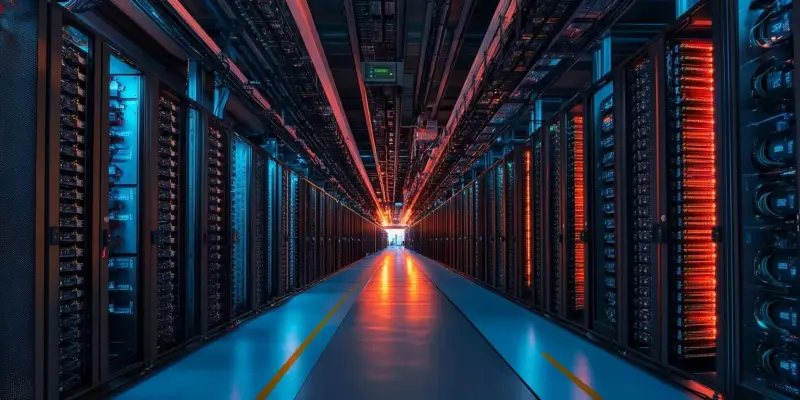Google’s Colossus system has emerged as a pivotal component in supporting the company’s vast array of services, including YouTube, Gmail, and Google Drive, handling immense amounts of data efficiently and reliably. Colossus, originally derived from the Google File System project, has been refined and adapted to cater to Google’s ever-growing storage demands. This article delves into the intricacies of Colossus, exploring its reliance on hard disk drives (HDDs) for the majority of its storage needs, its use of solid-state drives (SSDs) for enhanced performance, and the role of machine learning in optimizing data management.
Leveraging HDDs for Cost-Effective Storage
A key aspect of Google’s Colossus is its continued reliance on HDDs for bulk data storage, a decision driven by the cost-effectiveness and durability of magnetic hard disk drives. While advancements in storage technology have introduced newer, flash-based alternatives, the affordability and reliability of HDDs remain undeniable. Google harnesses the large storage capacity of HDDs to handle enormous volumes of data, ensuring that long-term storage needs are met without incurring exorbitant costs. This pragmatic approach has helped Colossus maintain scalability and accessibility for a global user base.
Colossus’s design underscores the importance of balancing cutting-edge performance with practical economic considerations. Although HDDs form the backbone of the storage infrastructure, Google’s strategic employment of SSDs ensures that high-speed, frequently accessed data can be managed more efficiently. This dual approach leverages the strengths of both storage technologies, allowing Google to deliver responsive services without sacrificing affordability. By effectively pooling HDDs and SSDs, Colossus is capable of accommodating surges in data traffic, adapting to fluctuating workloads, and providing consistent user experiences.
Superior Performance Through SSD Caching
To address the need for high-speed operations, Colossus incorporates an advanced SSD caching system that supercharges its performance capabilities. The L4 distributed SSD caching system is an innovative solution driven by machine learning algorithms that dynamically decide the optimal placement of data blocks. Initially, new data is stored on SSDs, capitalizing on the rapid read and write speeds these drives offer. Over time, as the need for instant access diminishes, data is transferred to HDDs for long-term storage. This method effectively marries the speed of SSDs with the capacity and cost-efficiency of HDDs.
Colossus’s use of SSD caching not only enhances performance but also optimizes cost management. By selectively assigning data to SSDs based on usage patterns, the system maximizes the duration that critical data remains on fast storage, reducing latency and improving user experiences. This approach is particularly beneficial for services that demand high throughput and low response times, such as video streaming and cloud-based applications. The intelligent caching system can predict data access trends, ensuring that frequently accessed files are readily available on SSDs, while less critical data is relegated to HDDs, thus maintaining an equilibrium between speed and cost.
Impressive Data Throughput and Adaptive Storage Policies
One of the standout features of Colossus is its remarkable data throughput capabilities. The largest clusters within the system boast read rates that exceed 50 terabytes per second and write rates of up to 25 terabytes per second. These figures translate to transferring over 100 full-length 8K movies every second, a testament to the robust infrastructure that supports Google’s expansive ecosystem of services. Such impressive throughput rates are crucial in maintaining the seamless operation of platforms like YouTube, where vast amounts of data are uploaded and accessed daily.
In addition to its high throughput, Colossus is characterized by its adaptive storage policies. These policies, determined by simulations that predict file access patterns, include instructions such as “place on SSD for one hour” or “place on SSD for two hours,” ensuring that data is efficiently managed according to predicted usage. This adaptability allows Colossus to optimize resource allocation by temporarily storing frequently accessed data on faster SSDs before migrating it to HDDs. The system’s ability to automatically adjust to changing workloads not only enhances performance but also ensures cost-effective storage solutions.
The Future of Google’s Storage Infrastructure
Google’s Colossus system has become a cornerstone in powering a wide range of the company’s services, such as YouTube, Gmail, and Google Drive, by managing vast amounts of data with both efficiency and reliability. Originally stemming from the Google File System project, Colossus has undergone numerous enhancements and adaptations to meet Google’s ever-increasing storage requirements. This piece delves into the nuances of Colossus, highlighting its primary dependence on hard disk drives (HDDs) for the bulk of its storage capabilities while leveraging solid-state drives (SSDs) to boost performance. Additionally, the article examines the integral role of machine learning in fine-tuning data management processes, thereby optimizing the system’s efficiency. The innovative blend of these technologies ensures that Colossus remains capable of supporting Google’s expansive and growing digital ecosystem, handling enormous data volumes seamlessly while maintaining high performance and dependability.

